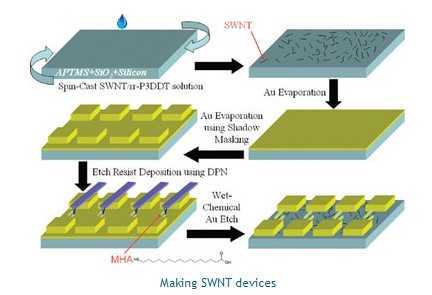Polymer helps separate CNT mix
When single-walled carbon nanotubes are made, a mixture of both metallic and semiconducting nanotubes is produced. This is a problem when trying to make electronic devices from nanotubes because, ideally, either semiconducting or metallic tubes are needed depending on the application and not both. Now, researchers in the US and Korea have proposed a new and simple way to efficiently separate the nanotubes using a polymer that disperses the semiconducting ones.

Single-walled carbon nanotubes (SWNTs) are rolled-up sheets of graphite just one atom thick and can be metallic or semiconducting depending on the direction in which the sheet has been rolled. This direction is also the tube‘s chirality, or handedness. They could be ideal as the building blocks in nanoscale electronics thanks to their small size and their ability to carry large currents. Metallic tubes could be used to make transparent conducting leads, for example, while semiconducting tubes could make good nanoscale transistors.
Although there are already several techniques to separate nanotubes, most of these are tricky to perform and cannot easily be scaled up to industrial levels. The new technique put forward by Zhenan Bao and colleagues at Stanford University and co-workers from the Frontier Research Lab at Samsung utilizes a polymer (rr-P3DDT) that selectively interacts with and disperses semiconducting SWNTs.
“We simply mix the SWNTs and the polymer together in an organic solvent, and then put the mixture in a sonic bath, ”explained team member Steve Park. The SWNTs do not dissolve in the solvent whereas the polymer dissolves very well. This means that only certain chiralities of SWNTs able to interact with the polymer are soluble in the solvent – in this case, they are all semiconducting tubes,he told nanotechweb.org.
Easily scaled up
The researchers then place the mix in a centrifuge and the undissolved, metallic SWNTS easily separate out and can be safely removed. Another advantage of the technique is that it can be scaled up and large quantities of semiconducting SWNTs potentially be obtained as needed. Moreover, because the polymer itself is semiconducting, there is no need to remove it once the process is complete.
The researchers confirmed that the SWNTs were semiconducting by making short-channel devices (using a dip-pen nanolithography technique) composed of individual SWNTs and measuring their electrical properties. A total of 190 devices were characterized and all were found to be semiconducting with an average on/off current ratio of around 106.
The semiconducting SWNTs can be made into high-performance transistors. They might also potentially be used as the active material in solar cells, and to make various types of chemical and biological sensors, say the researchers.
The work was reported in ACS Nano

